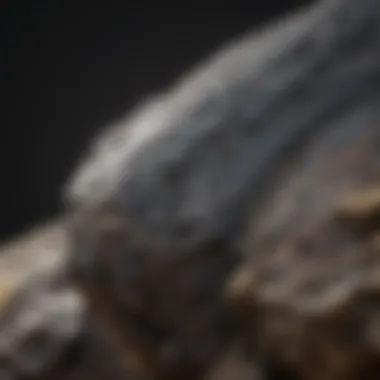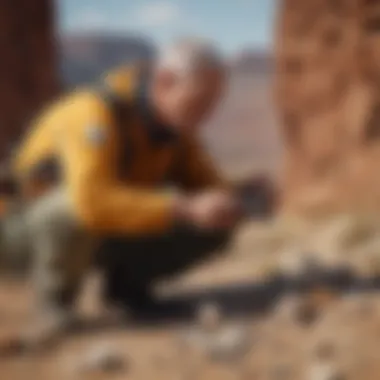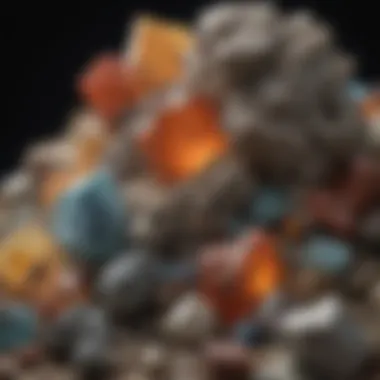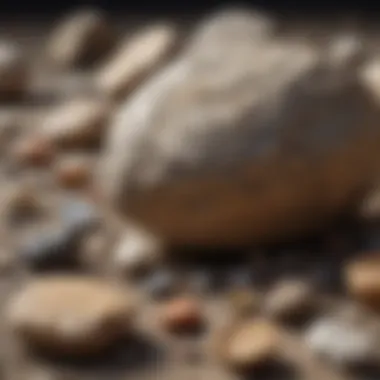Unlocking the Power of the Mohs Scratch Test for Rock and Fossil Enthusiasts


Rock and Fossil Identification
In the realm of rock and fossil collection, a fundamental aspect that discerning enthusiasts engage with is the aptitude to identify various geological specimens with precision and expertise. This subsection serves as a cornerstone in the grand design of comprehending the Mohs scratch test in its entirety. Before delving into the intricate details of the Mohs scratch test, it is imperative to grasp the diverse array of rocks and fossils that one may encounter. From sedimentary to igneous and metamorphic rocks, the spectrum of possibilities is vast and intriguing. Similarly, fossils come in a myriad of forms, from petrified remains to imprints of ancient life. As collectors venture into this domain, honing their perceptual skills to discern the unique characteristics of each specimen becomes essential. Tools play a pivotal role in this pursuit, aiding in precise identification through techniques such as streak testing, cleavage analysis, and of course, the venerable Mohs scratch test.
Introduction to Mohs Scratch Test
The Introduction to Mohs Scratch Test is a fundamental aspect of this article, shedding light on the significance of this test for rock and fossil collectors. This section serves as a gateway to understanding the Mohs scratch test, a vital tool in determining the hardness of minerals. By delving into the intricacies of this test, enthusiasts can gain insights that enhance their mineral identification processes. The Mohs Scratch Test introduction brings to the forefront the key role it plays in the realm of geology and collecting, setting the stage for a deeper exploration of this essential technique.
Foundational Concepts
What is Mohs Scratch Test?
Embarking on a journey to unlock the mysteries of mineral hardness, the "What is Mohs Scratch Test?" aspect scrutinizes the core methodology behind this test. A cornerstone of mineral identification, the Mohs Scratch Test offers a simple yet effective way to determine the relative hardness of various minerals. Its straightforward approach involves scratching a mineral with different reference materials to discern its hardness level. This method's appeal lies in its accessibility and ease of application, making it a go-to choice for both beginners and seasoned collectors. However, its simplicity also comes with limitations in accurately defining specific hardness values, which users must consider in their evaluation process.
The Scale of Hardness
Delving into "The Scale of Hardness," we unravel the structured framework that underpins the Mohs Scratch Test. This scale, devised by Friedrich Mohs in 1812, outlines a range of reference minerals with defined hardness levels from 1 (softest) to 10 (hardest). Each mineral's placement on this scale is based on its ability to scratch or be scratched by other minerals, offering a comparative system for assessing hardness. This standardized scale provides a valuable point of reference for collectors, enabling them to categorize minerals based on their scratch resistance. However, the scale's simplicity means it may not capture the nuanced hardness variations within mineral species, necessitating understanding and interpretation by users.
Importance in Mineral Identification
Unpacking the "Importance in Mineral Identification," we delve into the practical implications of the Mohs Scratch Test. Crucial for distinguishing between minerals of varying hardness, this test serves as a foundational tool in the broader scope of mineral identification. By revealing the relative scratch resistance of minerals, collectors can make educated assessments about geological specimens, aiding in their classification and categorization. The significance of this test lies in its ability to provide a tangible measure of hardness, facilitating informed decisions in mineral analysis. However, it is essential to recognize that the Mohs Scratch Test is just one facet of a comprehensive mineral identification toolkit, requiring complementary techniques for a thorough assessment of mineral properties.
Conducting the Mohs Scratch Test
The process of conducting the Mohs Scratch Test holds paramount importance within the realm of rock and fossil collection. By subjecting minerals to this test, collectors can ascertain the relative hardness of various specimens, aiding immensely in their classification and identification endeavors. Understanding the Mohs Scratch Test involves delving into the nuanced details of how different minerals respond to scratching, offering invaluable insights into their composition and physical properties.
Materials Needed


Testing Tools
In the realm of the Mohs Scratch Test, the choice of testing tools plays a crucial role in ensuring accurate results. The hardness picks, commonly used in this test, hold a specific design tailored to exert controlled pressure on mineral surfaces. These picks are crafted from materials of varying hardness levels themselves, allowing collectors to precisely gauge the resistance offered by different minerals. The versatility and durability of these testing tools make them a popular choice among enthusiasts, enabling meticulous examination without compromising accuracy.
Reference Minerals
The inclusion of reference minerals in the Mohs Scratch Test kit serves as a fundamental guide for collectors. These minerals, each possessing a distinct hardness level on the Mohs scale, provide a crucial benchmark for comparison during the testing process. By utilizing reference minerals with known hardness properties, collectors can calibrate their observations and establish a standardized basis for evaluating unknown specimens. This comparative approach enhances the reliability and repeatability of the test results, contributing significantly to the accuracy of mineral hardness determinations.
Step-by-Step Procedure
Preparing the Surface
Before embarking on the scratch test, it is imperative to prepare the surface of the mineral specimen adequately. Cleaning the surface to remove any debris or contaminants ensures a clear and unobstructed testing area. Additionally, flattening irregularities in the surface promotes uniform scratch patterns and facilitates accurate observation of the mineral's hardness response. This preparatory step sets the stage for precise and consistent testing outcomes, enabling collectors to make informed assessments of mineral hardness levels.
Scratch Testing
The actual scratch testing phase involves applying controlled pressure on the mineral surface using the designated hardness picks. By systematically increasing the hardness of the picks, collectors can determine the point at which the mineral surface incurs visible scratches. This process of sequential scratching allows for the mineral's hardness to be compared against known reference minerals, aiding in its classification according to the Mohs scale. Through meticulous observation and documentation of scratch characteristics, collectors can derive valuable insights into the relative hardness of the tested specimen.
Interpreting Results
Once the scratch test is complete, interpreting the results becomes crucial in extracting meaningful conclusions about the mineral's hardness. Analyzing factors such as scratch depth, width, and morphology enables collectors to assign the specimen a corresponding position on the Mohs scale of hardness. By correlating observed scratch patterns with established hardness levels, collectors can accurately categorize the mineral and glean insights into its composition and geological significance. The skillful interpretation of scratch test results is pivotal in the meticulous classification of minerals, enriching the understanding and appreciation of geological specimens.
Understanding the Hardness Scale
The topic of understanding the hardness scale plays a crucial role in this article as it is the foundation upon which the Mohs scratch test operates. By comprehending the hardness scale, rock and fossil collectors equip themselves with the knowledge necessary to assess the relative hardness of different minerals accurately. This understanding enables collectors to not only identify minerals but also distinguish them based on their hardness levels. Therefore, delving into the intricacies of the hardness scale enhances the precision and effectiveness of the Mohs scratch test, making it an indispensable tool in the realm of geological specimen classification and identification.
Mineral Hardness Levels


Softest Minerals (1-)
Within the realm of mineral hardness, the category of softest minerals (1-2) holds a distinct significance. These minerals exhibit the lowest level of hardness on the Mohs scale, making them susceptible to scratches from even the softest of materials. While their soft nature may seem like a vulnerability, it actually serves a crucial purpose in mineral identification. Soft minerals leave characteristic marks when subjected to the scratch test, aiding collectors in determining their hardness level accurately. Despite their susceptibility to damage, soft minerals provide valuable insights into the spectrum of hardness, acting as essential reference points for collectors aiming to classify mineral specimens.
Moderately Hard Minerals (3-)
Moving up the hardness scale, moderately hard minerals (3-5) present a diverse range of characteristics that bridge the gap between soft and hard minerals. With slightly higher hardness levels compared to their softer counterparts, minerals in this category offer collectors a unique challenge during hardness testing. Their resistance to scratching by softer minerals and ability to scratch materials of lower hardness underline their intermediate position on the Mohs scale. This versatility makes moderately hard minerals instrumental in refining collectors' skills in hardness assessment, contributing to a more nuanced understanding of mineral hardness variations.
Hard Minerals (6-)
Hard minerals (6-9) signify a considerable leap in hardness compared to their softer counterparts. These minerals exhibit substantial resistance to scratching and require harder tools or materials to leave a mark during the scratch test. With increased hardness levels, hard minerals present a robust challenge to collectors, highlighting the importance of precision and careful observation during hardness assessment. The distinct properties of hard minerals make them sought-after specimens for collectors looking to challenge their proficiency in mineral identification and classification.
Super Hard Minerals ()
At the apex of the hardness scale lie super hard minerals (10), exhibiting unparalleled resistance to scratching. Minerals in this category, such as diamonds, showcase exceptional hardness that puts them in a league of their own. Collectors encounter a significant challenge when testing super hard minerals, as conventional materials are ineffective in causing visible scratches on their surfaces. The unique properties of super hard minerals underscore the pinnacle of hardness on the Mohs scale, representing a rare and valuable class of specimens that demand meticulous handling and assessment.
Applications in Geology and Collecting
When it comes to rock and fossil collecting, the applications of the Mohs scratch test carry significant importance. This section delves into how the test impacts the identification and classification of geological specimens for enthusiasts at all levels. By understanding the hardness of minerals through this test, collectors can differentiate between various specimens accurately, aiding them in building and organizing their collections effectively. The direct application of the Mohs scratch test in geology allows collectors to make informed decisions about the specimens they encounter, contributing to a deeper understanding of the geological processes that have shaped our planet.
Geological Significance
Geological Mapping
Geological mapping plays a vital role in the field of geology and collecting. In the context of this article, geological mapping involves charting the distribution of different minerals based on their hardness levels in specific geological formations. This process provides collectors with valuable information about the mineral composition of a given region, helping them locate potential specimens of interest. One key characteristic of geological mapping is its ability to create visual representations of mineral distributions, which aids collectors in planning their expeditions more effectively. While there are technological advancements in mapping techniques, traditional geological mapping remains a popular choice due to its reliability and accuracy in pinpointing mineral-rich areas. Collectors benefit from the detailed insights provided by geological mapping, allowing them to strategize their collection efforts with precision.
Mineral Classification


In the realm of rock and fossil collecting, mineral classification serves as a fundamental aspect for enthusiasts. By categorizing minerals based on their hardness levels, collectors can better organize and present their collections. This article highlights the significance of mineral classification in facilitating the identification and differentiation of specimens in a collection. A key characteristic of mineral classification is its ability to systematize minerals according to their hardness, enabling collectors to showcase specimens based on their unique properties. While there are various methods of mineral classification, using the Mohs scale provides a standardized approach that simplifies the organization process for collectors. Understanding mineral classification assists collectors in contextualizing their specimens within broader geological contexts, enhancing the educational value of their collections.
Collecting Considerations
Protecting Specimens
The protection of specimens holds paramount importance for rock and fossil collectors. Ensuring the integrity of specimens prevents damage and deterioration over time, preserving their scientific and aesthetic value. This section focuses on the best practices for safeguarding specimens from environmental factors and physical harm. One key characteristic of protecting specimens is the use of specialized storage containers and preservation techniques that maintain the specimens' original condition. By employing proper protective measures, collectors prolong the lifespan of their specimens and retain their geological significance for future study. While there are various challenges in protecting specimens, adhering to strict conservation protocols offers numerous advantages, such as maintaining the authenticity of specimens and ensuring their long-term viability for research and display purposes.
Cataloging Collections
Cataloging collections plays a crucial role in the organization and documentation of rock and fossil specimens. In this article, cataloging collections is emphasized for its ability to create detailed records of each specimen, including information on hardness, locality, and geological significance. The key characteristic of cataloging collections lies in its systematic approach to inventory management, allowing collectors to track and monitor their specimens effectively. By establishing a robust cataloging system, collectors can easily retrieve information about each specimen, facilitating research and reference in the future. Despite the time and effort required for meticulous cataloging, the benefits far outweigh the drawbacks, as it enhances the overall value of a collection and contributes to the preservation of geological heritage.
Advanced Techniques and Aliernattves
Advanced Techniques and Alternatives play a pivotal role in exploring additional methods beyond the traditional Mohs scratch test. By delving into these advanced techniques, rock and fossil collectors can gain a more profound understanding of mineral hardness and composition. One particular aspect that stands out is the incorporation of Digital Hardness Testing, which leverages cutting-edge technologies to enhance the accuracy and efficiency of hardness assessments. The introduction of emerging technologies in this domain represents a significant leap forward in the field, offering collectors a more convenient and precise way of determining the hardness of specimens.
Digital Hardness Testing
Emerging Tonglcesignloges
Emerging Technologies in Digital Hardness Testing introduce innovative approaches that revolutionize the process of assessing mineral hardness. These technologies utilize state-of-the-art algorithms and equipment to provide collectors with highly accurate hardness measurements. The key characteristic of Emerging Technologies lies in their ability to offer rapid results while minimizing human error, making them a valuable asset in enhancing the overall testing procedure. Collectors find the unique feature of these technologies, such as real-time data analysis and precise measurements, incredibly beneficial for their research and collection efforts, despite the occassoiabl limitations that may arise. The continuous evolution and refinement of Emerging Technologies ensure that collectors have access to the most advanced tools for their mineralogical pursuits.
Benefits and Limitations
When considering the Benefits and Limitations of Digital Hardness Testing, it becomes evident how these aspects shape the efficiency and reliability of the testing process. The primary benefit lies in the speed and accuracy achievable through digital methods, enabling collectors to streamline their analyses and make informed decisions swiftly. Additionally, the reproducibility of results and the ability to store data digitally enhance the overall documentation and organization of hardness assessments. However, one limitation to be mindful of is the potential dependence on specific equipment or software, which could become a barrier for some collectors. Despite this drawback, the advantages of Digital Hardness Testing notably outweigh the limitations for rock and fossil collectors seeking to elevate their mineral identification practices.
Other Hardness Scales
Brinell Scale
The Brinell Scale offers an alternative approach to assessing hardness, utilizing indentation tests to determine the resistance of a material to surface penetration. One notable characteristic of the Brinell Scale is its applicability to a wide range of materials, including metals and harder specimens, making it a versatile choice for comprehensive hardness evaluations. The unique feature of this scale lies in the use of a spherical indenter to measure indentation diameter, providing a reliable indicator of hardness levels. While the Brinell Scale offers precise results for many materials, its main disadvantage is the potential for inaccuracies when testing softer specimens, necessitating vigilance during assessments.
Vickers Scale
In contrast, the Vickers Scale adopts a pyramid-shaped diamond indenter to evaluate hardness, offering a standardized approach to hardness testing. The key characteristic of the Vickers Scale is its ability to deliver accurate and consistent results for a wide range of materials, including both micro and macro-hardness assessments. This makes it a popular choice among collectors looking for a comprehensive and reliable hardness scale. The unique feature of the Vickers Scale lies in its capacity to measure extremely hard materials with precision, providing detailed insights into the hardness properties of diverse specimens. While the Vickers Scale excels in assessing a broad spectrum of materials, users may encounter challenges in interpreting results for certain compositions, requiring a nuanced understanding of hardness testing methods.







